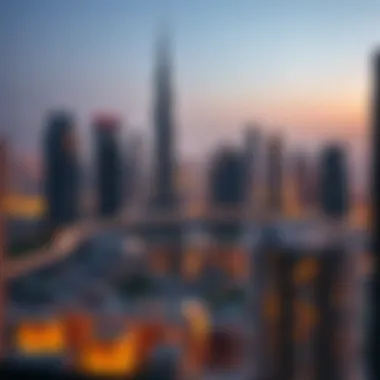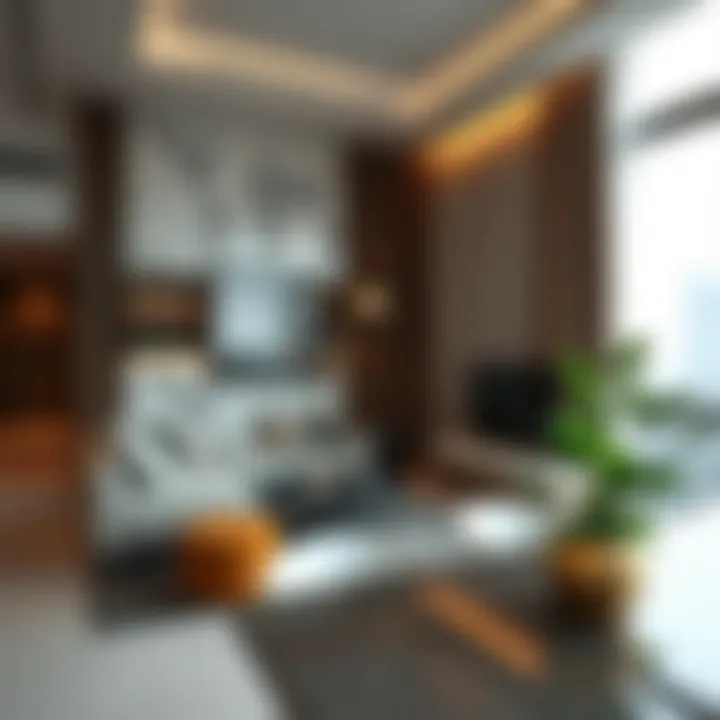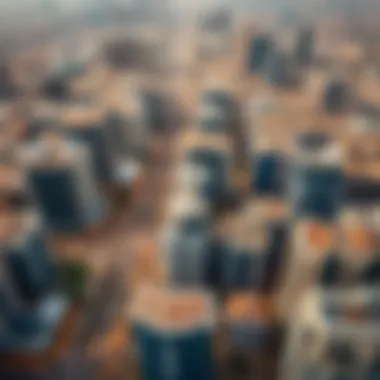Downtown Views: Analyzing Floor Plans in Dubai


Intro
In the shimmering metropolis of Dubai, where the skyline meets the sun, the architectural composition primarily hinges on floor plans that present breathtaking downtown views. As the real estate market shifts gears, these designs do more than merely frame a picture-perfect vista; they reflect the aspirations and lifestyles of Dubai's diverse inhabitants. From lavish penthouses overlooking the Burj Khalifa to contemporary apartments with views of the Arabian Gulf, each structure resonates with a story waiting to be told.
Understanding the significance of these floor plans becomes essential, especially for investors and homeowners looking to make informed decisions in a competitive landscape. This article unpacks the layers of this fascinating intersection between urban design and market trends, offering insights into how specific floor plans cater to various preferences and how they influence property value.
With a keen eye on trends and a look ahead to the future, we delve into market dynamics and tricks of the trade, sharing vital information that can empower both seasoned investors and first-time buyers navigating through this vibrant real estate market.
Prologue to Downtown Views
When one thinks about urban life, the imagery often conjured includes bustling streets, towering skyscrapers, and an array of activities just a stone’s throw from one’s doorstep. The concept of downtown living embodies more than just the physical space; it captures a way of life—one that centers around connectivity, culture, and community. The heartbeat of a city often echoes in its downtown area, making it a sought-after location for residents and investors alike.
In the realm of Dubai’s real estate market, the importance of having a view extends beyond mere aesthetics. Scenic visuals influence not just the living experience but also the value of properties significantly. A well-placed apartment with a panoramic view of iconic structures like the Burj Khalifa can fetch a premium. Exactly how significant these views are forms the backbone of our exploration.
Additionally, the floor plans designed to capitalize on these views bring an array of design considerations into play. The layout impacts the occupants' interaction with their surroundings, influencing everything from light intake to the open feeling of a space. In this article, we will delve into the intricacies of these floor plans, evaluating how they harmonize with urban design principles and cater to the diverse lifestyles that populate Dubai.
The Concept of Downtown Living
Downtown living transcends traditional housing; it’s about immersing oneself in the vibrancy of an urban environment. Proximity to amenities—be it bustling markets, parks, cultural hotspots, or dining options—creates a unique lifestyle. Residents want not just a home but a lifestyle infused with convenience and excitement.
This lifestyle can be defined by community engagement, accessibility, and the sheer energy that flows through a city. It invites possibilities and experiences, allowing individuals to be part of something larger than themselves. With that said, considerations of design play a crucial role. Optimally designed floor plans must ensure that residents can engage with the life outside while providing comfort and sanctuary within.
Importance of Views in Urban Design
Having a view can be a game changer in urban living. It’s not just about looking out onto a street; it’s about what is seen through those windows. A dynamic skyline or serene waterfront can elevate a space from ordinary to extraordinary. Urban design must consider these elements while maintaining functionality and sustainability.
A few key points highlight why views matter in urban design:
- Psychological Wellbeing: Studies show natural light and scenic views contribute positively to mental health. They can lower stress levels and improve overall happiness.
- Market Value: Properties with better views tend to have higher resale value, making them attractive investments.
- Community Connection: Views can enhance a sense of belonging. For instance, overlooking a lively plaza can encourage social interactions and community events.
"Design is not just what it looks like and feels like. Design is how it works." – Steve Jobs
For investors, architects, and homebuyers, understanding the interplay between views and floor plans is essential. It informs decisions that can affect both the quality of living and the potential for future gains. In the following sections, we will dissect further how modern architectural trends and personal preferences shape the landscape of downtown views in Dubai.
Architectural Perspectives
Understanding the architectural perspectives of downtown views is paramount, especially when analyzing the real estate offerings in a vibrant city like Dubai. Architects and urban planners face the dual challenge of creating visually stunning spaces while also ensuring functionality. This balance greatly affects how potential residents and buyers perceive the value of properties. In this section, we will dive into modern architectural trends and the integration of nature into urban designs, showcasing how these elements contribute to the overall allure of a downtown living experience.
Modern Architectural Trends
Modern architecture reflects the evolving needs of urban populations. In Dubai, a city known for pushing the limits of architectural innovation, several trends have emerged:
- Sustainability: Green building practices are taking center stage, focusing on energy efficiency and the reduction of carbon footprints. Innovations like solar panels and greywater recycling systems are becoming commonplace in residential buildings.
- Smart Homes: Technology integration is not just a luxury but a necessity for today's buyers. From remotely controlled lighting to full-scale home automation systems, the expectation for tech-savvy spaces is rising.
- Mixed-Use Developments: These offer a blend of residential, commercial, and recreational spaces, allowing for convenience and a sense of community. Living in such environments often organically promotes a vibrant lifestyle, attracting a more diverse range of residents.
The aesthetic element cannot be ignored either. Designers are increasingly adopting bold shapes and distinctive features, drawing inspiration from Middle Eastern traditions and modern minimalist styles alike.
Integrating Nature with Urban Spaces
As urban environments become denser, the importance of integrating nature into city landscapes gains traction. Nature not only provides aesthetic beauty but also serves numerous psychological and lifestyle benefits for residents.
- Biophilic Design: This approach marries architecture with nature. Features like indoor gardens, large windows for maximum natural light, and green rooftops not only beautify but also promote well-being. Exposure to natural elements has been shown to reduce stress and enhance mental health.
- Parks and Green Corridors: Developers are increasingly recognizing the value of maintaining outdoor spaces within city designs. These green areas serve as oases amid urban hustle, where residents can escape the buzz of city life, engage in recreational activities, or simply unwind.
- Water Features: Incorporating fountains, ponds, or reflecting pools can significantly enhance the aesthetic, creating vibrant community hubs.


Integrating natural elements helps foster a sense of connection not only to the environment but to each other. As buyers increasingly prioritize these aspects, properties that capitalize on nature's integration typically see enhanced demand.
"As cities expand and urban living becomes the norm, architectural innovation that harmonizes with the environment is key to appealing to modern buyers."
In summary, the architectural perspectives in downtown developments go beyond mere aesthetics. They encompass sustainability, technological integration, and nature's place amidst urban sprawl, shaping the future of living in metropolitan areas.
Floor Plans and Layouts
In the realm of downtown living, floor plans and layouts serve as the foundation upon which lifestyles are built. They are not just blueprints but integral components that influence daily activities and interactions within urban spaces. A well-thought-out floor plan can significantly enhance the living experience, marrying aesthetics with functionality. In bustling metropolises like Dubai, where real estate is prized for both its location and views, understanding how layouts contribute to residential enjoyment is crucial for investors and buyers alike.
Considerations around floor plans go beyond merely fitting furniture into rooms; they encapsulate the essence of how space can be optimized for comfort and usability. For example, the placement of windows not only affects light but also the kind of views residents will enjoy — be it the iconic skyline of Dubai or serene water vistas. Therefore, the importance of floor plans and layouts cannot be overstated, as they dictate everything from the flow of space to the overall ambiance.
Common Floor Plan Configurations
When one thinks of apartment configurations in downtown settings, several common styles come to mind. Each configuration, in its own right, addresses various needs and preferences of urban dwellers. Popular layouts include studios, one-bedroom, and multi-bedroom apartments. These designs cater to diverse demographics, from young professionals seeking compact living spaces to families in need of more expansive options.
- Studios: These typically feature an open living space that combines living, dining, and sleeping areas into a single zone. This configuration is often favored for its efficiency and cost factor, making it attractive for first-time buyers and renters.
- One-bedroom layouts: These layouts generally offer a separate bedroom, allowing for increased privacy while retaining a combined living space. They strike a balance between comfort and cost, appealing to a wider audience.
- Multi-bedroom configurations: Ideal for larger families or shared living, these plans usually have separated rooms and often feature one or more bathrooms. Versatility is a key trait, allowing for shared space while preserving individual privacy.
These common layouts facilitate not only specific preferences but also wider trends in how urban residents choose to inhabit their spaces.
Optimizing Space for Comfort
Maximizing comfort in urban environments hinges on effective space utilization, a task often executed through two primary concepts: Open Concept Designs and Defined Spaces and Privacy.
Open Concept Designs
Open concept designs have surged in popularity, embodying a modern approach to spatial configuration. One key characteristic is the absence of traditional barriers like walls, merging living spaces into one expansive area. This feature notably promotes a sense of community and seamless interaction among family members or guests.
The unique advantage of such designs is their potential for natural light flow. A well-placed window or glass door can amplify brightness, making spaces feel larger and more inviting. However, one must acknowledge a downside—noise control. In an open space, sounds can travel freely, making it harder for residents to enjoy a quiet moment alone or focus on separate activities like work or hobbies.
Defined Spaces and Privacy
On the flip side, defined spaces prioritize privacy and separation within a living environment. This approach allows for individual rooms tailored for specific functions, like bedrooms away from living areas. The primary appeal of this configuration is the certainty it provides for daily life. Each resident can engage in their own activities without disrupting others, catering to those who value personal space.
A significant feature of defined spaces is that they can often include dedicated storage solutions. For instance, a hallway may house hidden cabinets, enhancing both aesthetics and organization. Despite these advantages, sometimes these layouts can feel constrained, particularly in smaller apartments where room sizes might subsequently seem limiting.
Understanding the balance between open and defined spaces is an essential part of evaluating how urban living can adapt to individual lifestyles.
Thus, examining floor plans and layouts within the context of downtown views is crucial as it shapes the experience for residents in the ever-evolving landscape of urban living in Dubai.
Market Trends and Buyer Preferences
Understanding market trends and buyer preferences is pivotal in the complex landscape of Dubai's downtown real estate. The appeal of downtown living has skyrocketed, fostering an intense environment where properties must cater explicitly to evolving demands. These trends dictate the values of properties, shape investor decisions, and ultimately influence the economic pulse of urban living. Thus, an insight into these elements can illuminate the dynamics of property selection and investment potential, making it invaluable for agents and buyers alike.
Current Trends in Downtown Real Estate
Currently, one of the most compelling trends is the demand for buildings that offer a blend of luxury and functionality. Developers are responding with designs that include expansive views, smart technologies, and community-driven spaces. This response isn't merely about aesthetics; it’s deeply rooted in a lifestyle shift where residents favor environments fostering social interaction while maintaining private spaces.
- Skyward Living: With the increasing appreciation for terrace gardens, high-rises now feature stunning rooftop lounges ideal for relaxation or gatherings, appealing to those yearning for an urban oasis.
- Sustainable Designs: Eco-friendly materials and energy-efficient systems are also on the rise, as buyers increasingly prioritize sustainability. Properties that can demonstrate an environmentally conscious design are more likely to attract discerning investors.
- Cultural Integration: A notable movement within developments is integrating local culture, which enhances the living experience. This authenticity resonates particularly with expatriates seeking a slice of Dubai's rich heritage.
Factors Influencing Buyer Choices
View Orientation


The orientation of a view in a property is often the primary selling point. A flat facing the Burj Khalifa, for example, is likely to command a higher price point compared to one overlooking a busy street. This direct correlation between view orientation and property value cannot be understated. Buyers often perceive scenic views as a premium asset, contributing to an emotional appeal that goes beyond mere functionality.
The distinct characteristic of prime view orientation lies in its ability to create a serene living atmosphere. Properties that showcase panoramic vistas deliver a sense of tranquility, making their residents feel more connected to nature, albeit within a bustling city.
"A view is more than just a backdrop; it’s a window into a lifestyle."
However, it’s important to recognize there are trade-offs. For instance, units with unobstructed views may face exposure to high wind, increased noise levels or even glare from the sun. Potential buyers need to weigh these factors against the desirability of the views themselves.
Proximity to Amenities
When chasing the ideal living situation, proximity to amenities plays a crucial role too. Essentially, how close the property is to shopping centers, restaurants, parks or public transport significantly impacts buyer choices. Being within walking distance to these conveniences not only increases comfort but also enhances overall lifestyle quality.
The essence of this characteristic is the convenience it brings. A property nestled near vibrant urban hubs offers residents an exciting mix of experiences at their doorstep, appealing particularly to young professionals and families alike.
On the downside, being near popular attractions might mean facing challenges like traffic congestion or noise, which may deter some buyers who prefer quieter settings. It becomes a balancing act between enjoying urban vibrancy and seeking a peaceful retreat.
In summation, as the downtown landscape of Dubai evolves, keeping an eye on market trends and buyer preferences offers critical insight into the factors driving property value. For stakeholders involved, recognizing the impact of views and accessibility can significantly enhance investment decisions.
The Role of Views in Property Value
In the bustling real estate market of Dubai, property values are often influenced by a myriad of factors, and one stand-out aspect that has garnered attention is the role of views. It's not just about having a roof over your head anymore; it’s about what you can see from that roof. A stunning view can elevate a mundane space into a prime investment opportunity.
Impact of Scenic Views on Market Pricing
When it comes to pricing properties, having a scenic view—be it of the iconic Burj Khalifa, the calm waters of the Arabian Gulf, or the vibrant city skyline—can significantly enhance market value. Properties that boast breathtaking vistas often command higher sales prices compared to those without. This phenomenon can be attributed to two primary factors:
- Psychological Appeal: A beautiful view can create a positive emotional response. Many potential buyers envision themselves sipping coffee in the morning while taking in a picturesque sunset or watching the city lights twinkle at dusk.
- Market Demand: As urban living becomes increasingly popular, views from a property have become a desirable feature. Buyers are often willing to pay a premium for locations that provide these satisfying visual experiences.
Consider this: buyers often prioritize homes with east or west-facing views to capture the warmth of sunrise or sunset, respectively. Others might focus on properties that overlook parks, rivers, or historical sites, reflecting not just aesthetic preference but potential long-term value appreciation.
Case Studies: Properties with Iconic Views
Looking closely at examples can illustrate the power of views on property value.
- The Address Downtown Dubai: This upscale property not only provides views of the Burj Khalifa but also overlooks the Dubai Fountain, a major tourist attraction. According to market analysts, listings here have seen property prices soar up to 30% higher than similar units without fountain views.
- Dubai Marina Towers: Units here offer breathtaking views of the marina itself and the Arabian Gulf. Recent sales have indicated that properties with direct waterfront views sell at a premium, often exceeding expectations by a startling 20% on the market.
- Jumeirah Beach Residence (JBR): Known for its beachside views, JBR properties frequently sell quicker than their land-locked counterparts. The allure of living close to the beach, coupled with vistas of the sea and the horizon, has priced these units higher, maintaining strong market demand even during economic slight fluctuations.
In summary, having a scenic view can substantially increase property value. Buyers are not merely investing in brick and mortar but are instead purchasing a lifestyle that comes with captivating views. The intrinsic value tied to these visual experiences often translates into significant financial gains, making it crucial for investors and stakeholders in Dubai's ever-evolving real estate landscape to pay keen attention to views when considering property investments.
Challenges in Urban Design
In examining downtown views and floor plans in Dubai, it becomes evident that urban design faces a myriad of challenges. These are not just obstacles, but critical components that can shape the future of city living. As urban developers and architects sketch out blueprints, they must grapple with the balance between aesthetics, functionality, environmental sustainability, and community needs. Understanding these challenges is pivotal for investors, architects, and buyers alike, as they influence not only property values but also the overall livability of urban environments.
Balancing Aesthetics and Functionality
When we talk about balancing aesthetics and functionality in urban design, it’s like walking a tightrope. On one hand, there’s the desire for stunning architectural marvels that catch the eye and elevate the skyline. However, these visual spectacles must also serve practical purposes, accommodating everyday needs of residents.
For instance, a residential tower overlooking Dubai Creek might feature panoramic glass façades. Visually arresting, yes, but does it account for energy efficiency and glare reduction? That’s where the challenge lies. A beautifully designed building should not overshadow practicality; they must coalesce to create an inviting space.
Points to consider include:
- User Experience: How does the layout support daily activities? Is it easy for residents to navigate?
- Longevity: Materials and designs should stand the test of time, facing both environmental and urban wear.
- Community Integration: Focusing on designs that invite social interactions helps enhance community bonds. Having open spaces, green areas, and access to amenities is essential for residents.
"Good design is about making things work well while looking great, like a well-tailored suit that fits perfectly."
This balance will undoubtedly continue to evolve as urbanization advances, guiding the future planning of cities.


Addressing Environmental Concerns
In today’s rapidly changing world, addressing environmental concerns is no longer optional but rather a necessity in urban design. As cities expand, the impact on the environment becomes more pronounced. For Dubai, where the climate poses unique challenges, designers face an uphill battle.
The core issues include:
- Sustainable Materials: Utilizing eco-friendly materials helps reduce carbon footprints. There’s a growing trend toward using reclaimed or sustainably sourced materials.
- Energy Efficiency: Integrating solar panels or green roofs can significantly lower energy consumption. Heat-regulating windows not only enhance comfort but also reduce reliance on air conditioning systems.
- Water Management: In a region that is largely desert, innovative solutions for water conservation, such as rainwater harvesting systems or xeriscaping, are crucial to sustainable urban design.
Each of these facets must be part of the conversation as projects develop from the conceptual stage to completion. As stakeholders in Dubai's real estate market understand these challenges, they can better appreciate how environmental strategies not only preserve asset value but also contribute to a healthier cityscape for future generations.
Future Outlook
The future of downtown views and their integration into architectural designs is an evolving sphere of interest. Potential buyers and investors are increasingly leaning towards properties that promise not just shelter, but an experience—something that tantalizes the senses while meeting practical needs. This section aims to illuminate the importance of innovative floor plan strategies, emphasizing the dynamics of urban development and changes in societal preferences.
Investors are wise to pay attention to emerging trends within this domain. As many urban areas face overpopulation, the design philosophies tend to shift, prioritizing vertical living spaces that offer breathtaking views of cityscapes. Developers are pressing forward with plans that challenge conventional designs, aiming to create environments that resonate with social connectivity, nature, and skyline aesthetics. This kind of foresight can enhance return on investment significantly.
Emerging Design Trends
As we look ahead, several noteworthy trends are making waves in urban design.
- Sustainable Building Practices: Increasingly, developers are adopting eco-friendly materials and energy-efficient technologies, leading not only to greener living spaces but also increasing marketability among environmentally conscious buyers. Solar panels, green roofs, and rainwater harvesting systems are just a few examples.
- Smart Home Technology: The integration of technology into design isn't merely about aesthetics anymore. Features like smart thermostats, automated lighting, and state-of-the-art security systems are becoming standard, appealing to a tech-savvy clientele that values comfort and convenience.
- Mixed-Use Developments: There's a growing trend towards spaces that blend residential, commercial, and recreational facilities. Properties that incorporate retail, dining, and leisure in one cohesive environment appeal to buyers looking for a vibrant lifestyle.
- Flexible Spaces: With the rise of remote working, layouts that allow for home offices or multipurpose rooms are in higher demand. Flexibility is the name of the game, providing potential owners with dynamic spaces that can adapt to various needs.
These trends are not just fleeting; they signify a shift in how urban living will be conceptualized in the coming years.
Predictions for the Downtown Real Estate Market
The real estate market in downtown areas is often a reliable indicator of broader economic health. As city populations swell and urban lifestyles evolve, certain predictions are surfacing about the future landscape of this market.
- Increased Demand for View Properties: Scenic views are becoming increasingly coveted. Properties that showcase iconic landscapes are likely to experience elevated market pricing, attracting affluent buyers and foreign investors.
- Urban Redevelopment Projects: More downtown areas are embracing revitalization efforts to enhance community appeal, leading to a rise in both new construction and renovations of older structures. Government incentives for such projects can further stimulate interest.
- Rising Prices but Slowing Price Growth: While property prices are trending upward, the rate at which they increase is predicted to stabilize, demanding strategic foresight from investors. Economic factors, such as interest rates and employment rates, will continue to play a crucial role in pricing dynamics.
"Understanding these market predictions can give significant leverage to investors aiming for long-term gains."
- Focus on Health and Wellbeing: Post-pandemic, potential buyers are showing more interest in properties that foster a sense of wellbeing—think open spaces, access to nature, and community parks. Developers are likely to focus on creating environments that prioritize not just engagement, but also health.
In closing, staying responsive to these upcoming trends and predictions not only shapes individual investment strategies but contributes to a more harmonious urban living experience.
Culmination
In wrapping up this exploration of downtown views in floor planning within Dubai's real estate landscape, it is worthwhile to reflect on several key elements that underpin the significance of this shared topic.
Firstly, the integration of views into floor plans is not simply an aesthetic consideration; it holds tangible economic value. Properties that boast scenic downtown views often command higher prices, thus making them appealing to investors and improving the likelihood of quicker sales. Scenic views can significantly enhance a buyer’s perception of a property, adding a perceived value that goes beyond just brick and mortar.
To summarize key insights, it’s essential to underline the crucial role of urban aesthetics. Buyers are not merely looking for a place to live; they seek a holistic lifestyle experience. Spaces designed with open concepts that culminate in breathtaking vistas give residents a sense of connection to the vibrant city life. Additionally, while creating these views, the importance of balancing functionality and comfort remains a primary focus in contemporary urban planning.
Another noteworthy aspect discussed is the relationship between amenities and property desirability. A well-placed window or balcony can transform everyday living, enabling citizens to engage with urban nature and community life just outside their doors. In this context, developing properties that emphasize the unique skyline or cultural landmarks can provide sellers an edge in a competitive market.
Moreover, it’s imperative for prospective buyers and investors to be mindful of ongoing trends, particularly as they relate to sustainability and environmental concerns. Future designs must resonate with not only current aesthetic preferences but also consider ecological impacts and practices.
Summarizing Key Insights
- Economic Impact: Downtown views elevate property pricing, giving a competitive edge in real estate.
- Enhancing Lifestyle: Views enrich daily living experiences, marrying comfort and aesthetic beauty.
- Design Balance: Urban planning must focus on optimizing layout for functionality while delivering visually striking spaces.
- Sustainability Trends: Future buildings should address environmental concerns while retaining unique views and community access.
As we look towards the future of urban real estate in Dubai, it’s clear that the landscapes will continue to evolve. Emphasis on view-oriented designs, coupled with effective market strategies that target lifestyle aspirations, should guide future investments and home-buying decisions.
Encouragement for Future Exploration
Encouraging further exploration into this intriguing nexus of design and functionality, the ongoing shifts in urban landscapes opens up dialogue for potential innovations in floor planning. Urban centers like Dubai are not static; they reinvent themselves continuously. Investors, agents, and homebuyers should keep their ears to the ground as trends unfold, aligning with cutting-edge design principles that enhance both the skyline and day-to-day living.
As prospective buyers or stakeholders in the real estate market, having an awareness of these dynamics will allow you to make informed decisions. Engage actively in market assessments, observing not only current designs but also conceptual frameworks that cater to future urban lifestyles. Become familiar with essential community features, and don’t hesitate to leverage resources that provide insight into emerging trends.











